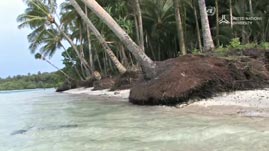Teachers' Domain - Digital Media for the Classroom and Professional Development
User: Preview

Source: United Nations University – Institute of Advanced Studies Traditional Knowledge Initiative
Carteret Islanders (of Papua New Guinea) describe how climate change is destroying their home island of Han, in these two videos adapted from UNU-IAS Traditional Knowledge Initiative and Pacific Black Box, Inc. In the first video, Nicholas Hakata explains that flooding carries sand inland, creates mosquito breeding grounds, destroys property, and causes starvation. His fellow islanders discuss relocating the community. In the second video, teenager Jerryanne Hugo talks about the crop destruction and water shortage caused by sea level rise. Note: The first video, narrated by Hakata in his native language, is subtitled in English.
A Girl's Video Diary on Climate Change in the Pacific (Video)
Vocabulary:
In the Pacific Islands, half the population lives just above sea level, less than 1.5 kilometers from the coast. As air and ocean temperatures increase, sea level is rising. As a result, flooding is likely to affect freshwater resources, the food supply, and public health. Some communities have already decided to relocate to safer places.
Flooding can contaminate freshwater supplies with salt water and ruin valuable farmland. It can also help spread diseases by creating the swampy conditions in which insects thrive. Flooding from high tides, especially “king tides” (the highest tides of the year), is already causing widespread damage. Like all tides, king tides are influenced by the pull of the Moon’s gravity and, to a lesser extent, the Sun’s. When the Moon appears at its brightest (a full moon) or darkest (a new moon), the Moon and the Sun are both pulling on Earth’s water from the same direction. During those times of the month, the high tides are higher than average.
Fresh water is a valuable but limited resource on many Pacific islands, especially low islands and atolls. The communities on these islands must collect rainwater for drinking, washing, and cooking. Ground water, where it exists, is contained in natural underground formations called aquifers. On low-lying islands, ground water floats on top of salt water from the ocean—forming a freshwater lens. This happens because fresh water is less dense than salt water. Most low-island wells pump water from a freshwater lens system.
Aquifers and lenses are good sources of fresh water, but only if they are protected from pollution and carefully managed. Sewage and chemicals used in agriculture can seep into ground water and contaminate it. Pumping out too much water or pumping it out too quickly can draw the salty water to the surface. It only takes a small amount of salt to make fresh water unusable for drinking or irrigation (water for farming).
Freshwater supplies on Pacific islands are at risk both from manmade threats, such as pollution and overpumping, and from natural ones. Climate change influences weather patterns. Today, islands in the Pacific experience longer droughts, forcing islanders to rely more on pumping from underground sources. These sources will shrink if they are not refilled as quickly as the water is used.
Pacific Islanders are already feeling the effects of climate change on their way of life. Many more islanders may have to relocate in the next few decades because of these effects. The cost of relocating individuals or entire communities will be high, but the financial cost does not compare to the cultural cost of separating a people from their ancestral home.
To learn more about sea level rise and tide patterns in the Pacific Islands, including how people in the Pacific Islands can adapt to the impacts of rising sea levels, check out Sea Level Rise in the U.S. Affiliated Pacific Islands (PDF).
Here are suggested ways to engage students with these videos and with activities related to this topic.
Class activity: Use balls of various sizes (for example, a basketball, a ping-pong ball, and a marble) to model the Sun, Earth, and the Moon. Demonstrate the movement of Earth and the Moon relative to the Sun. Then discuss tidal forces and how the alignment of the three bodies affects tides.
Class activity—extension: Look up (on the Internet or in some other reference) the concepts of apogee/perigee and aphelion/perihelion and discuss them. Then discuss how the relative distances between the Sun, Earth, and the Moon interact with their alignment to produce king tides.
 Loading Standards
Loading Standards